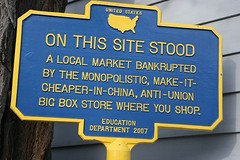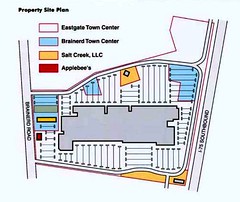The Post offers new ideas for obsolete big boxes

Posted November 17, 2008 at 1:30PM
Writing in yesterday's Washington Post, Joel Garreau (Edge City, Radical Evolution) collects ideas from several accomplished designer and developer types on how to reshape old big-box retail stores into spaces more suited to the 21st-century.
It's a subject I've covered before, both here and in NRDC's 2001 book Solving Sprawl, where we hailed designs for such "grayfield" redevelopment and reuse in Chattanooga (TN), Rutland (VT), and Mountain View (CA). One of the most famous designs for a great retrofit was developed by my friend Victor Dover and his architecture firm Dover, Kohl for an old mall in Chattanooga, Eastgate Town Center. It was praised not only in our book but also in Greyfields to Goldfields by the Congress for the New Urbanism. See how the big box is transformed into a walkable, mixed-use neighborhood, step by step:
Nifty, no? But there's a cautionary tale in there, and I'll return to Eastgate later.
Garreau's story leads with a reference to yet another optimistic book, Big Box Reuse, by artist Julia Christensen and scheduled for publication this month by MIT Press. Garreau quotes Christensen:
"In the background is this very large problem that is being thrust upon our landscape. The big-box buildings themselves were not necessarily wanted in the first place. These corporations are not held accountable for the fact that they are building hundreds and hundreds of buildings that will be abandoned in the future. Luckily, our communities are incredibly resourceful, finding amazing things to do with these buildings. That's key. That's the balance of this project, the thrust of the message."
Christensen's web site features 16 images of successful adaptations, ten of which are detailed in her book.
 It is certainly a challenge we had best become wise to. Although buildings can be with us for centuries (and some adapted beautifully to new functions), retail space turns over at an astonishingly high rate. Real estate researcher Arthur C. Nelson reports that fully 24% of our nonresidential development goes out of service each decade, and that the typical lifespan of retail development is less than 20 years.
It is certainly a challenge we had best become wise to. Although buildings can be with us for centuries (and some adapted beautifully to new functions), retail space turns over at an astonishingly high rate. Real estate researcher Arthur C. Nelson reports that fully 24% of our nonresidential development goes out of service each decade, and that the typical lifespan of retail development is less than 20 years.
Garreau reports that 189 Walmarts are currently for sale on Walmartrealty.com, and that there are 4,224 currently functioning Walmarts in the US. And that's just one big-box retailer.
In their current guises these places are environmental disasters, a single Walmart frequently occupying 200,000 square feet or more of single-story indoor space, into which one could fit about five football fields. Likewise for some other mega-retailers. The giant stores are almost completely automobile-dependent and are typically surrounded by 15-20 acres of paved parking lots. While we can appreciate the attempts by various big-box chains to become incrementally more sustainable, it is basically putting lipstick on a . . . oh, never mind.
 Garreau's designers and developers come up with a range of ideas for repurposing the boxes, from the practical to the whimsical:
Garreau's designers and developers come up with a range of ideas for repurposing the boxes, from the practical to the whimsical:
- Chris Leinberger suggests converting the parking lots into walkable, mixed-use city blocks, much as Victor designed for Eastgate;
- Roger Lewis proposes hollowing out the inside of a big box to create courtyard gardens, adding skylights to the roof, and windows to the exterior, all for apartments;
- Several designers suggest replacing the roofs with translucent materials to allow light for indoor gardens (or vineyards!), noting that the buildings already have helpful infrastructure for irrigation and climate control;
- Artists Peter Winant and Tom Ashcraft suggest rolling in railroad cars and freight containers to create modular artists' co-ops and performance spaces.
You get the idea. Provocative responses to a serious challenge. But, while I completely agree with the seriousness of the challenge, I have to note what Garreau does not: responses equal to the challenge won't come easy, particularly in the current economy. Remember the great plan for Eastgate, at the top of this post?
For the most part, it never happened. In the late 1990s, when we were researching our book and CNU was working on theirs, it looked like a go, a great success story in the making.
But economic realities interfered with new urbanist visions. Eastgate did get a $30-million facelift, including a new food court, a brick exterior, and the conversion of some retail space to offices. But it never became a neighborhood. Today the site is still configured as a 70s-style shopping mall, and a third of the project's space is being advertised for lease. The current site plan is just above.
Garreau's article, and drawings by the participants, may be viewed here.

